11.5E: Exercises
- Page ID
- 30575
\( \newcommand{\vecs}[1]{\overset { \scriptstyle \rightharpoonup} {\mathbf{#1}} } \)
\( \newcommand{\vecd}[1]{\overset{-\!-\!\rightharpoonup}{\vphantom{a}\smash {#1}}} \)
\( \newcommand{\dsum}{\displaystyle\sum\limits} \)
\( \newcommand{\dint}{\displaystyle\int\limits} \)
\( \newcommand{\dlim}{\displaystyle\lim\limits} \)
\( \newcommand{\id}{\mathrm{id}}\) \( \newcommand{\Span}{\mathrm{span}}\)
( \newcommand{\kernel}{\mathrm{null}\,}\) \( \newcommand{\range}{\mathrm{range}\,}\)
\( \newcommand{\RealPart}{\mathrm{Re}}\) \( \newcommand{\ImaginaryPart}{\mathrm{Im}}\)
\( \newcommand{\Argument}{\mathrm{Arg}}\) \( \newcommand{\norm}[1]{\| #1 \|}\)
\( \newcommand{\inner}[2]{\langle #1, #2 \rangle}\)
\( \newcommand{\Span}{\mathrm{span}}\)
\( \newcommand{\id}{\mathrm{id}}\)
\( \newcommand{\Span}{\mathrm{span}}\)
\( \newcommand{\kernel}{\mathrm{null}\,}\)
\( \newcommand{\range}{\mathrm{range}\,}\)
\( \newcommand{\RealPart}{\mathrm{Re}}\)
\( \newcommand{\ImaginaryPart}{\mathrm{Im}}\)
\( \newcommand{\Argument}{\mathrm{Arg}}\)
\( \newcommand{\norm}[1]{\| #1 \|}\)
\( \newcommand{\inner}[2]{\langle #1, #2 \rangle}\)
\( \newcommand{\Span}{\mathrm{span}}\) \( \newcommand{\AA}{\unicode[.8,0]{x212B}}\)
\( \newcommand{\vectorA}[1]{\vec{#1}} % arrow\)
\( \newcommand{\vectorAt}[1]{\vec{\text{#1}}} % arrow\)
\( \newcommand{\vectorB}[1]{\overset { \scriptstyle \rightharpoonup} {\mathbf{#1}} } \)
\( \newcommand{\vectorC}[1]{\textbf{#1}} \)
\( \newcommand{\vectorD}[1]{\overrightarrow{#1}} \)
\( \newcommand{\vectorDt}[1]{\overrightarrow{\text{#1}}} \)
\( \newcommand{\vectE}[1]{\overset{-\!-\!\rightharpoonup}{\vphantom{a}\smash{\mathbf {#1}}}} \)
\( \newcommand{\vecs}[1]{\overset { \scriptstyle \rightharpoonup} {\mathbf{#1}} } \)
\( \newcommand{\vecd}[1]{\overset{-\!-\!\rightharpoonup}{\vphantom{a}\smash {#1}}} \)
\(\newcommand{\avec}{\mathbf a}\) \(\newcommand{\bvec}{\mathbf b}\) \(\newcommand{\cvec}{\mathbf c}\) \(\newcommand{\dvec}{\mathbf d}\) \(\newcommand{\dtil}{\widetilde{\mathbf d}}\) \(\newcommand{\evec}{\mathbf e}\) \(\newcommand{\fvec}{\mathbf f}\) \(\newcommand{\nvec}{\mathbf n}\) \(\newcommand{\pvec}{\mathbf p}\) \(\newcommand{\qvec}{\mathbf q}\) \(\newcommand{\svec}{\mathbf s}\) \(\newcommand{\tvec}{\mathbf t}\) \(\newcommand{\uvec}{\mathbf u}\) \(\newcommand{\vvec}{\mathbf v}\) \(\newcommand{\wvec}{\mathbf w}\) \(\newcommand{\xvec}{\mathbf x}\) \(\newcommand{\yvec}{\mathbf y}\) \(\newcommand{\zvec}{\mathbf z}\) \(\newcommand{\rvec}{\mathbf r}\) \(\newcommand{\mvec}{\mathbf m}\) \(\newcommand{\zerovec}{\mathbf 0}\) \(\newcommand{\onevec}{\mathbf 1}\) \(\newcommand{\real}{\mathbb R}\) \(\newcommand{\twovec}[2]{\left[\begin{array}{r}#1 \\ #2 \end{array}\right]}\) \(\newcommand{\ctwovec}[2]{\left[\begin{array}{c}#1 \\ #2 \end{array}\right]}\) \(\newcommand{\threevec}[3]{\left[\begin{array}{r}#1 \\ #2 \\ #3 \end{array}\right]}\) \(\newcommand{\cthreevec}[3]{\left[\begin{array}{c}#1 \\ #2 \\ #3 \end{array}\right]}\) \(\newcommand{\fourvec}[4]{\left[\begin{array}{r}#1 \\ #2 \\ #3 \\ #4 \end{array}\right]}\) \(\newcommand{\cfourvec}[4]{\left[\begin{array}{c}#1 \\ #2 \\ #3 \\ #4 \end{array}\right]}\) \(\newcommand{\fivevec}[5]{\left[\begin{array}{r}#1 \\ #2 \\ #3 \\ #4 \\ #5 \\ \end{array}\right]}\) \(\newcommand{\cfivevec}[5]{\left[\begin{array}{c}#1 \\ #2 \\ #3 \\ #4 \\ #5 \\ \end{array}\right]}\) \(\newcommand{\mattwo}[4]{\left[\begin{array}{rr}#1 \amp #2 \\ #3 \amp #4 \\ \end{array}\right]}\) \(\newcommand{\laspan}[1]{\text{Span}\{#1\}}\) \(\newcommand{\bcal}{\cal B}\) \(\newcommand{\ccal}{\cal C}\) \(\newcommand{\scal}{\cal S}\) \(\newcommand{\wcal}{\cal W}\) \(\newcommand{\ecal}{\cal E}\) \(\newcommand{\coords}[2]{\left\{#1\right\}_{#2}}\) \(\newcommand{\gray}[1]{\color{gray}{#1}}\) \(\newcommand{\lgray}[1]{\color{lightgray}{#1}}\) \(\newcommand{\rank}{\operatorname{rank}}\) \(\newcommand{\row}{\text{Row}}\) \(\newcommand{\col}{\text{Col}}\) \(\renewcommand{\row}{\text{Row}}\) \(\newcommand{\nul}{\text{Nul}}\) \(\newcommand{\var}{\text{Var}}\) \(\newcommand{\corr}{\text{corr}}\) \(\newcommand{\len}[1]{\left|#1\right|}\) \(\newcommand{\bbar}{\overline{\bvec}}\) \(\newcommand{\bhat}{\widehat{\bvec}}\) \(\newcommand{\bperp}{\bvec^\perp}\) \(\newcommand{\xhat}{\widehat{\xvec}}\) \(\newcommand{\vhat}{\widehat{\vvec}}\) \(\newcommand{\uhat}{\widehat{\uvec}}\) \(\newcommand{\what}{\widehat{\wvec}}\) \(\newcommand{\Sighat}{\widehat{\Sigma}}\) \(\newcommand{\lt}{<}\) \(\newcommand{\gt}{>}\) \(\newcommand{\amp}{&}\) \(\definecolor{fillinmathshade}{gray}{0.9}\)Practice Makes Perfect
In the following exercises, graph.
- \(\frac{x^{2}}{9}-\frac{y^{2}}{4}=1\)
- \(\frac{x^{2}}{25}-\frac{y^{2}}{9}=1\)
- \(\frac{x^{2}}{16}-\frac{y^{2}}{25}=1\)
- \(\frac{x^{2}}{9}-\frac{y^{2}}{36}=1\)
- \(\frac{y^{2}}{25}-\frac{x^{2}}{4}=1\)
- \(\frac{y^{2}}{36}-\frac{x^{2}}{16}=1\)
- \(16 y^{2}-9 x^{2}=144\)
- \(25 y^{2}-9 x^{2}=225\)
- \(4 y^{2}-9 x^{2}=36\)
- \(16 y^{2}-25 x^{2}=400\)
- \(4 x^{2}-16 y^{2}=64\)
- \(9 x^{2}-4 y^{2}=36\)
- Answer
-
1.
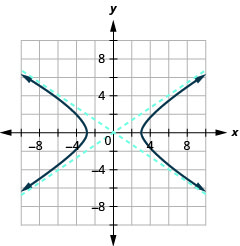
Figure 11.4.33 3.
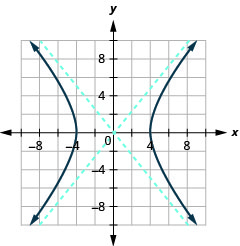
Figure 11.4.34 5.
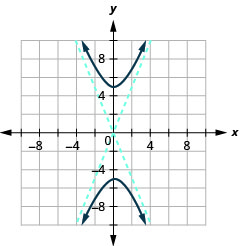
Figure 11.4.35 7.
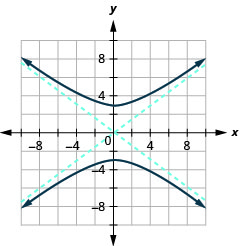
Figure 11.4.36 9.
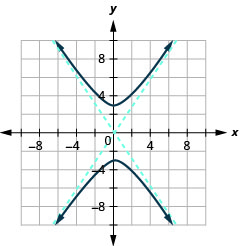
Figure 11.4.37 11.
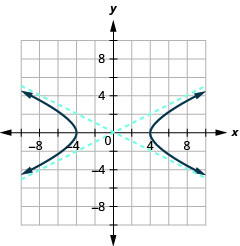
Figure 11.4.38
In the following exercises, graph.
- \(\frac{(x-1)^{2}}{16}-\frac{(y-3)^{2}}{4}=1\)
- \(\frac{(x-2)^{2}}{4}-\frac{(y-3)^{2}}{16}=1\)
- \(\frac{(y-4)^{2}}{9}-\frac{(x-2)^{2}}{25}=1\)
- \(\frac{(y-1)^{2}}{25}-\frac{(x-4)^{2}}{16}=1\)
- \(\frac{(y+4)^{2}}{25}-\frac{(x+1)^{2}}{36}=1\)
- \(\frac{(y+1)^{2}}{16}-\frac{(x+1)^{2}}{4}=1\)
- \(\frac{(y-4)^{2}}{16}-\frac{(x+1)^{2}}{25}=1\)
- \(\frac{(y+3)^{2}}{16}-\frac{(x-3)^{2}}{36}=1\)
- \(\frac{(x-3)^{2}}{25}-\frac{(y+2)^{2}}{9}=1\)
- \(\frac{(x+2)^{2}}{4}-\frac{(y-1)^{2}}{9}=1\)
- Answer
-
1.
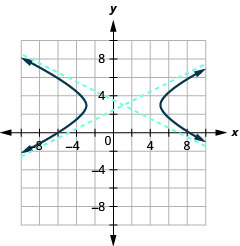
Figure 11.4.39 3.
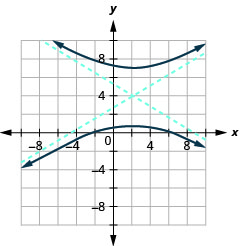
Figure 11.4.40 5.
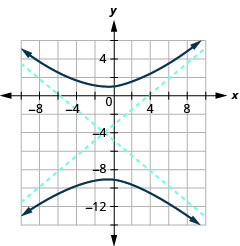
Figure 11.4.41 7.
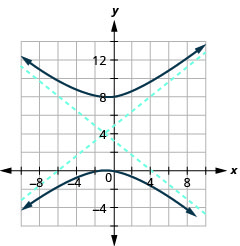
Figure 11.4.42 9.
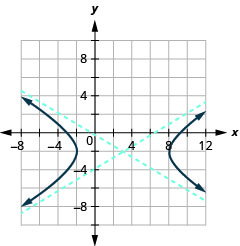
Figure 11.4.43
In the following exercises,
- Write the equation in standard form and
- Graph.
- \(9 x^{2}-4 y^{2}-18 x+8 y-31=0\)
- \(16 x^{2}-4 y^{2}+64 x-24 y-36=0\)
- \(y^{2}-x^{2}-4 y+2 x-6=0\)
- \(4 y^{2}-16 x^{2}-24 y+96 x-172=0\)
- \(9 y^{2}-x^{2}+18 y-4 x-4=0\)
- Answer
-
1.
- \(\frac{(x-1)^{2}}{4}-\frac{(y-1)^{2}}{9}=1\)
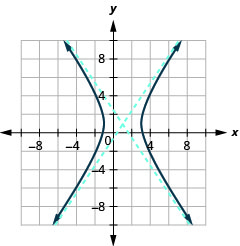
Figure 11.4.44 3.
- \(\frac{(y-2)^{2}}{9}-\frac{(x-1)^{2}}{9}=1\)
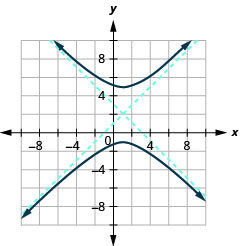
Figure 11.4.45 5.
- \(\frac{(y+1)^{2}}{1}-\frac{(x+2)^{2}}{9}=1\)
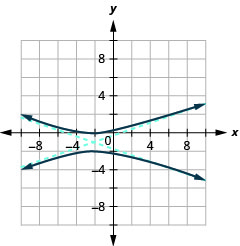
Figure 11.4.46
In the following exercises, identify the type of graph.
-
- \(x=-y^{2}-2 y+3\)
- \(9 y^{2}-x^{2}+18 y-4 x-4=0\)
- \(9 x^{2}+25 y^{2}=225\)
- \(x^{2}+y^{2}-4 x+10 y-7=0\)
-
- \(x=-2 y^{2}-12 y-16\)
- \(x^{2}+y^{2}=9\)
- \(16 x^{2}-4 y^{2}+64 x-24 y-36=0\)
- \(16 x^{2}+36 y^{2}=576\)
- Answer
-
2.
- Parabola
- Circle
- Hyperbola
- Ellipse
In the following exercises, graph each equation.
- \(\frac{(y-3)^{2}}{9}-\frac{(x+2)^{2}}{16}=1\)
- \(x^{2}+y^{2}-4 x+10 y-7=0\)
- \(y=(x-1)^{2}+2\)
- \(\frac{x^{2}}{9}+\frac{y^{2}}{25}=1\)
- \((x+2)^{2}+(y-5)^{2}=4\)
- \(9 x^{2}-4 y^{2}+54 x+8 y+41=0\)
- \(x=-y^{2}-2 y+3\)
- \(16 x^{2}+9 y^{2}=144\)
- Answer
-
2.

Figure 11.4.47 4.
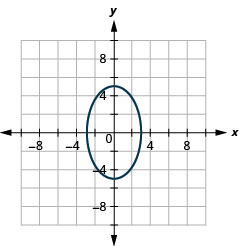
Figure 11.4.48 6.
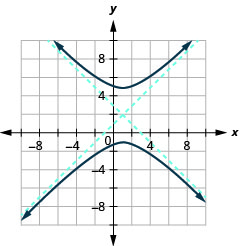
Figure 11.4.49 8.
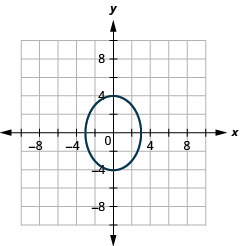
Figure 11.4.50
- In your own words, define a hyperbola and write the equation of a hyperbola centered at the origin in standard form. Draw a sketch of the hyperbola labeling the center, vertices, and asymptotes.
- Explain in your own words how to create and use the rectangle that helps graph a hyperbola.
- Compare and contrast the graphs of the equations \(\frac{x^{2}}{4}-\frac{y^{2}}{9}=1\) and \(\frac{y^{2}}{9}-\frac{x^{2}}{4}=1\).
- Explain in your own words, how to distinguish the equation of an ellipse with the equation of a hyperbola.
- Answer
-
2. Answers may vary
4. Answers may vary
Self Check
a. After completing the exercises, use this checklist to evaluate your mastery of the objectives of this section.

b. On a scale of 1-10, how would you rate your mastery of this section in light of your responses on the checklist? How can you improve this?


